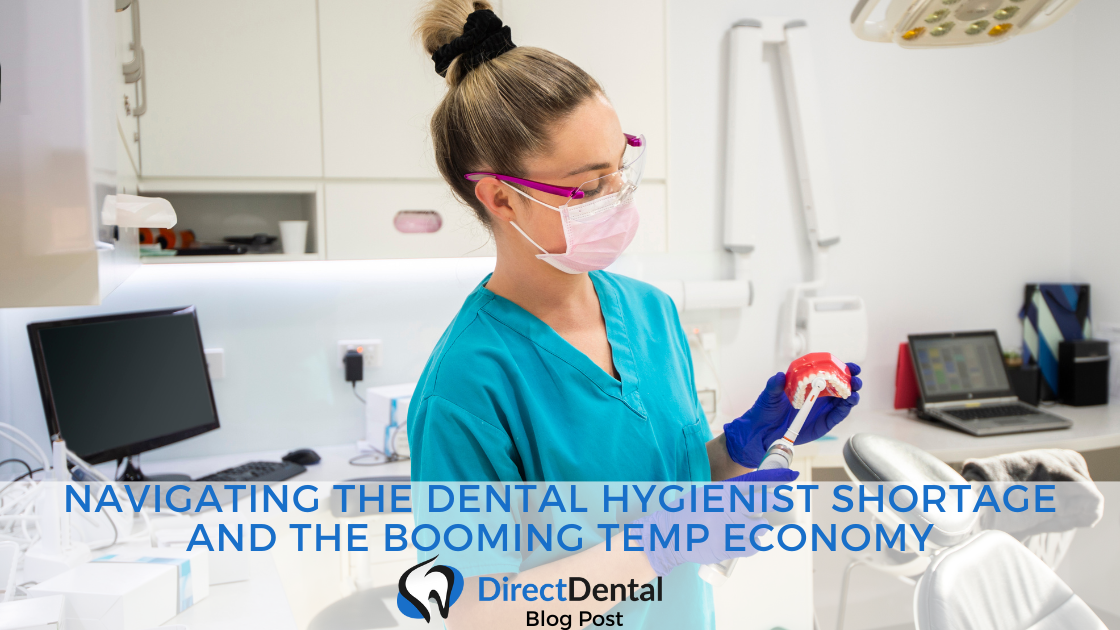It’s no secret that finding dental hygienists has only gotten more difficult since the pandemic. Today’s blog post comes from Andrea Kowalczyk, BS, RDH and deals with some hiring strategies for dental offices looking to retain permanent dental hygienists.
“Having lived on both the Texas and Florida coasts, I’ve seen my share of hurricane force winds. If you’ve ever seen a huge oak tree that seems immovable shaken violently by strong gusts, you know that its branches land in odd places.
To me, the dental field used to be like that unmoving oak, and the pandemic, the strong gust. Things landed in odd places. Many of us are still wondering what happened, and the answer depends on where you landed.
The most impactful change has been the complete reversal of a once-saturated hygiene employment market. Today, there’s an official shortage of working dental hygienists in the US. It’s so widespread that news of the shortage has been covered by such media outlets as NPR, USA Today, and US News and World Report.1
In 2019, hygiene openings attracted dozens of qualified applicants. In the decade before the pandemic, social media was full of new hygienists warning those pursuing the profession to change course, as there were no quality positions to be had. Now, it’s a hygienists’ market.
The tables have turned
For hygienists still working, many are realizing pay increases, benefits, work/life balance, and multiple employer options. Those are undeniable positives, and it stands to reason that these happier hygienists will provide even better patient care due to their increased career satisfaction.
But what about those who left?
Dental professionals, more than most health-care workers, literally came face-to-face with COVID-19 most days. Despite the safety of enhanced PPE, some hygienists powered down their ultrasonic units and headed for the hills. Many found the distancing, testing, vaccine requirements, and extra PPE too cumbersome to be worth the hassle.2
You may also be interested in: A “new normal” for dental staffing?
Some wanted to eliminate the commute and found remote careers. Those contemplating retirement reasoned this was the ideal time. For others, school and childcare closures forced them to stay home. Some decided that spending more time with their families was more meaningful than working outside the home.3
Enter temping
Hygiene temping—which for a long time was (unfairly) viewed as being primarily for the unemployable or semiretired—became the new black. There are many benefits to temping, and online dental temp matching apps allow hygienists to book themselves for when, where, and how much pay.4
It doesn’t hurt that many platforms provide same-day pay at wages higher than market. A few offer vacation and medical benefits to those who work a minimum number of days per month. It can be challenging for permanent employers to compete (although they may not have to forever). But short-term stints over the long haul can take a toll on a provider, just as it can for anyone who substitutes in a job that isn’t “theirs.”
Managing the unknowns
When temping for the first time in a practice, the unknowns can be stressful and lead to an exhausting workweek. These include making a great impression in an unfamiliar environment, untried software/technology and documentation protocols, and shorter or longer appointment times than the temp is accustomed to. Thousands of temps find ways to work around these challenges every day. But is it sustainable at current levels?
Patient perception and revenue suffer when a practice frequently uses temps. Most temps just try to get through the day, not learn the nuances of the practices’ perio program. It’s not that temps don’t want to do the right thing for patients. But the constraints on time and training, along with unfamiliar technology, can make comprehensive and confident hygiene care difficult.
If the temp is unfamiliar with the software, comprehensive charting is compromised. If they’re not aware of the practice’s assessment protocols, patients may not be getting periodontal, oral cancer, or caries risk screenings.
A common complaint practice leaders have about temps is that they work too fast or too slow. But it can be difficult to achieve cadence in a brief time, in new surroundings. Most teams need weeks together to all dance to the same beat. If a practice relies on new faces frequently, patient retention and revenue will suffer.”
Read the rest of the article on DentistryIQ to gain helpful insights into hiring and retaining permanent dental hygienists in your practice. We hope these strategies lead to the right balance of permanent and temporary hygienists in your practice.
Smiles,
Holli Perez
DirectDental
DirectDental- How it works for Dental Professionals
DirectDental- How it works for Dental Offices
DirectDental Home Page



